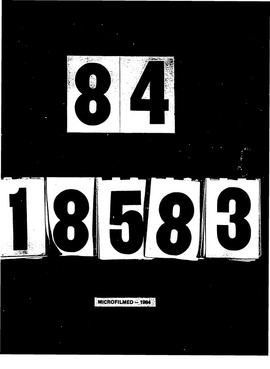| dc.contributor.author | Jolly, Eric J., | en_US |
| dc.date.accessioned | 2013-08-16T12:29:04Z | |
| dc.date.available | 2013-08-16T12:29:04Z | |
| dc.date.issued | 1984 | en_US |
| dc.identifier.uri | https://hdl.handle.net/11244/5234 | |
| dc.description.abstract | Two experiments are presented which redefine traditional dimensions of similarity in flavor of a model of perceived similarity. In Experiment 1, subjects were given information about themselves and others along an attitude dimension. These "others" comprised four groups representing different levels of breadth and homogeneity. Subjects were asked to select a preferred group for discussion of the attitude topic. In Experiment 2 the "others" had not been assigned to groups, and subjects were asked to construct the group they would prefer to work with. Results indicate that subjects prefer reference groups which are constructed in a manner consistent with their cognitive style. Additionally, the comparison process for group construction is shown to be different from the process of comparison to established groups. Implications for the theory of social comparison and the apparent drive-like functions of CW are discussed. | en_US |
| dc.description.abstract | Ambiguity tolerance (AT) identifies a person's tendency to seek out or avoid ambiguous situations and problems. Category width (CW) identifies a person's tendency to make consistent errors of inclusion or exclusion in the creation of group boundaries. After identifying the structural properties of groups which relate to breadth of membership and homogeneity of membership, we demonstrate the utility of CW and AT for predicting individuals' selection of comparison groups. | en_US |
| dc.description.abstract | According to social comparison theory, when the motivation for self evaluation predominates, people actively seek the opportunity to make comparisons of their attitudes and abilities with the most similar other available. Research of individual-to-individual comparison processes has demonstrated that externally defined dimensions of "similarity" can be effective predictors of one's selection of a comparison reference. The individual difference dimensions, ambiguity tolerance and category width, were used to extend our understanding of the concept of similarity, by examining internally (subjectively) defined dimensions of "similarity". | en_US |
| dc.format.extent | 71, [29] leaves ; | en_US |
| dc.subject | Psychology, Social. | en_US |
| dc.title | Social comparison and the perception of similarity / | en_US |
| dc.type | Thesis | en_US |
| dc.thesis.degree | Ph.D. | en_US |
| dc.thesis.degreeDiscipline | Department of Psychology | en_US |
| dc.note | Source: Dissertation Abstracts International, Volume: 45-05, Section: B, page: 1623. | en_US |
| ou.identifier | (UMI)AAI8418583 | en_US |
| ou.group | College of Arts and Sciences::Department of Psychology | |
